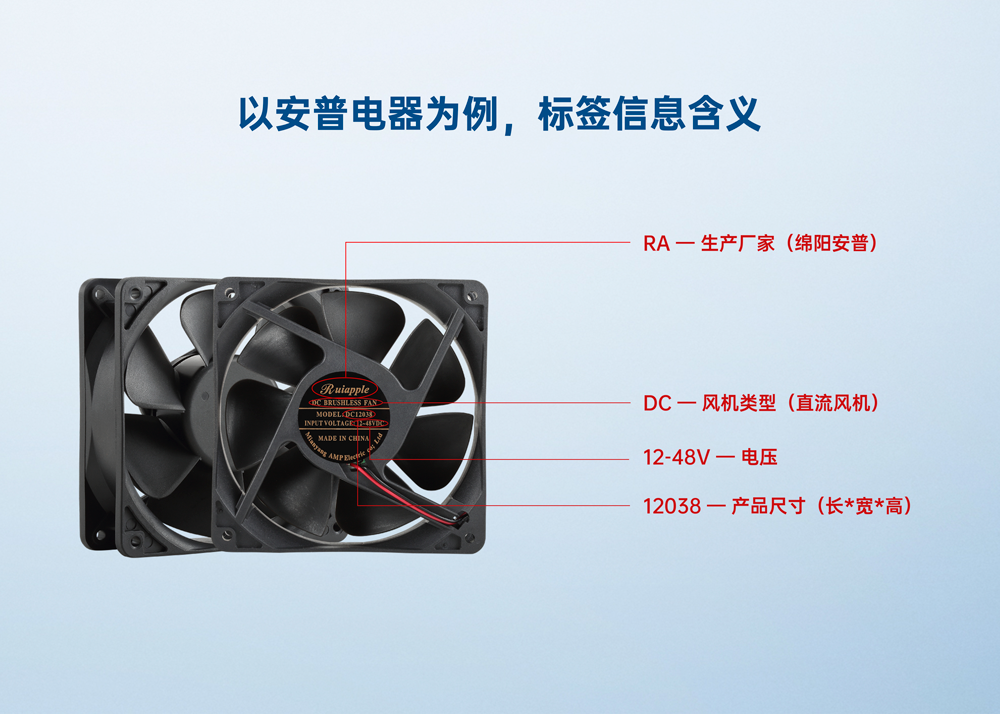When selecting or replacing a cooling fan, understanding its key specifications and materials is crucial, especially for manufacturers or users lacking technical experience. If a cooling fan fails and the model information is unavailable, how can you determine the correct replacement? Below is a detailed guide to help you accurately match the required fan.
1. Identifying the Manufacturer
- Check the Fan Label: If the label is intact and includes manufacturer details, contact them with a photo to obtain the exact replacement.
- Consult the Equipment Supplier: If the label only provides partial specifications but no manufacturer details, inquire with the equipment supplier to identify the original fan.
- Match by Key Parameters: If no manufacturer information is available, measure and record dimensions (length, width, thickness), operating voltage, bearing type, RPM, current, and additional features to find a suitable alternative.

2. Determining the Fan Size
Cooling fan sizes are typically expressed in L × W × H format. For example, a 12038 fan has dimensions of 120mm × 120mm × 38mm.
- Measurement Method: Use a ruler or caliper. If unavailable, compare with known objects such as a smartphone.
- Common Sizes:
- Small fans: 10mm, 15mm, 20mm, 25mm, 32mm, 38mm thickness.
- Standard axial fans: 25mm or 38mm thickness.
- In a model like 12012, “120” refers to length and width, while "12" typically represents voltage rather than thickness.
3. Identifying Power Type (DC/AC)
- Wire Color:
- AC fans: Usually have two wires of the same color (often black).
- DC fans: Typically use red (positive) and black (negative) wires.
- Label Markings: The label generally indicates "AC" or "DC".
4. Determining Fan Voltage
After identifying the power type, check the specific voltage rating:
- AC Fans: Common voltages are 110V and 220V (220V is standard in most regions).
- DC Fans: Common voltages include 5V, 12V, 24V, and 48V.
- Testing Method (For Professionals Only): If the label is missing, voltage can be gradually increased (e.g., from 5V to 12V to 24V) to determine the correct working voltage.
5. Identifying the Bearing Type
The bearing directly affects fan lifespan and noise levels. Common types include:
- Sleeve Bearing (HS): Low cost, short lifespan, suitable for light-duty applications.
- Ball Bearing (HB): Long lifespan, suitable for high-temperature and high-load environments.
- Dual Ball Bearing: Extended durability, ideal for industrial applications.
- Fluid Dynamic Bearing (FDB): Uses fluid lubrication for low noise and long life.
- How to Identify:
- Labels may include bearing type: “HB” for ball bearings, “HS” for sleeve bearings.
- If unlabeled, manually spin the fan blades:
- Ball bearings rotate smoothly.
- Sleeve bearings exhibit more resistance.
6. Identifying Fan Speed and Airflow
- RPM (Revolutions Per Minute): Determines cooling efficiency. Higher RPM increases airflow but also noise.
- Typical range: 2000-8000 RPM, industrial fans can exceed 10,000 RPM.
- CFM (Cubic Feet per Minute): Measures airflow capacity.
- For example, a 12038 fan typically provides 60-100 CFM.
- Current (A): Higher current usually means higher power and RPM.
- Example: 12V 0.3A fan = 3.6W power consumption.
7. Identifying Additional Features
Certain applications require enhanced fan capabilities:
- Waterproof & Dustproof:
- Encapsulated fans may show visible waterproof coatings.
- Vacuum-coated fans require specification checks to confirm.
- PWM Speed Control: Fans with PWM (Pulse Width Modulation) control have four wires:
- Red (VCC): Power positive
- Black (GND): Power negative
- Blue (PWM): Speed control
- Yellow (FG): Speed feedback
- Temperature Control: Fans with temperature sensors adjust RPM based on ambient temperature.
- Operational Monitoring: Fans with FG signal feedback provide real-time RPM data to monitoring systems.
Conclusion
When identifying a cooling fan, consider size, voltage, bearing type, speed, airflow, and additional features. Accurate measurements and comparisons ensure the correct fan selection, optimizing equipment performance and longevity.
As a professional cooling fan manufacturer, Ruiapple Electric offers a wide range of high-performance fans designed for various environments. If you need assistance in choosing the right fan, feel free to contact us for technical support and expert recommendations.






